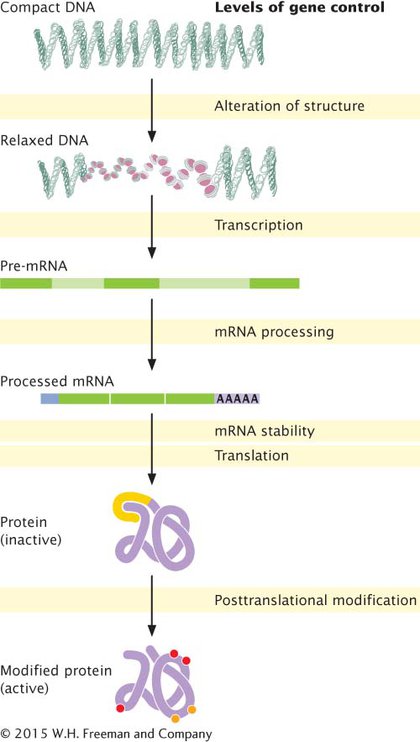Levels of Gene Regulation
In both bacteria and eukaryotes, genes can be regulated at a number of levels along the pathway of information flow from genotype to phenotype (Figure 12.1).

First, genes may be regulated through the alteration of DNA or chromatin structure; this type of gene regulation takes place primarily in eukaryotes. Modifications to DNA or its packaging may help to determine which sequences are available for transcription or the rate at which sequences are transcribed. DNA methylation and changes in chromatin are two processes that play a pivotal role in gene regulation.
A second point at which a gene can be regulated is at the level of transcription. For the sake of cellular economy, limiting the production of a protein early in the process makes sense, and transcription is an important point of gene regulation in both bacterial and eukaryotic cells.
A third potential point of gene regulation is mRNA processing. Eukaryotic mRNA is extensively modified before it is translated: a 5′ cap is added, the 3′ end is cleaved and polyadenylated, and introns are removed (see Chapter 10). These modifications determine the stability of the mRNA, the movement of the mRNA into the cytoplasm, whether the mRNA can be translated, the rate of translation, and the amino acid sequence of the protein produced. There is growing evidence that a number of regulatory mechanisms in eukaryotic cells operate at the level of mRNA processing.
A fourth point for the control of gene expression is the regulation of mRNA stability. The amount of protein produced depends not only on the amount of mRNA synthesized, but also on the rate at which the mRNA is degraded.
A fifth point of gene regulation is at the level of translation, a complex process requiring a large number of enzymes, protein factors, and RNA molecules (see Chapter 11). All of these factors, as well as the availability of amino acids, affect the rate at which proteins are produced and therefore provide points at which gene expression can be controlled. Translation can also be affected by sequences in mRNA.
Finally, many proteins are modified after translation (see Chapter 11), and these modifications affect whether the proteins become active; therefore, genes can be regulated through processes that affect posttranslational modification. Gene expression can be affected by regulatory activities at any or all of these points.
CONCEPTS
Gene expression can be controlled at any of a number of levels along the molecular pathway from DNA to protein, including DNA or chromatin structure, transcription, mRNA processing, mRNA stability, translation, and posttranslational modification.
 CONCEPT CHECK 2
CONCEPT CHECK 2
Why is transcription a particularly important level of gene regulation in both bacteria and eukaryotes?
Transcription is the first step in the process of information transfer from DNA to protein. For cellular efficiency, gene expression is often regulated early in the process of protein production.